News
Giggs: The night Antonio Conte provoked me into confronting Sir Alex Ferguson - it didn't end well

I will never forget the first time in my playing career I came up against Antonio Conte because it was the night that I ended up in my first big argument with Sir Alex Ferguson and there was only ever going to be one winner in that situation.
Because Marcello Lippi played a 4-3-3 formation in an era when just about every English side played 4-4-2, there was always a decision to be made for his opposing manager as to whether to change – as there often is now with Conte’s 3-4-3 at Chelsea. That night Sir Alex Ferguson decided that we would match Juventus and play 4-3-3 ourselves but by half-time it had turned into a nightmare for me.
"Like all good teams, Chelsea made the pitch feel very small when they do not have the ball and then, in an instant, when they do have it they can make the pitch feel very big"
We were 1-0 down to Alen Boksic’s goal but that was only half the story. I was in midfield with Nicky Butt and David Beckham. The problem, in my view, was Eric Cantona had always been used to playing with a strike partner and functioned best that way. He had Jordi Cruyff and Karel Poborsky either side of him, but my main complaint was that Eric was not showing for the ball enough and at half-time I decided to make my feelings known.
For that day you have to go back to September 1996, I was 22 years old, and Juventus, with Conte as their captain, were the best team in the world. The previous May I had been to the Champions League final in Rome as a guest of my boot sponsor, Reebok, where Juventus had beaten Louis Van Gaal’s Ajax team on penalties and it had been an eye-opener for me.
Juventus were the standard that any team with aspirations to win the Champions League had to reach, and we were no different at United. Juventus were different to what I knew. They played a 4-3-3 formation and by the time we went to Turin to play the defending champions in that autumn of 1996, they had a new star. Zinedine Zidane had joined from Bordeaux and he operated in a midfield three with Conte and Didier Deschamps. By any standards, that is a pretty useful trio of footballers.
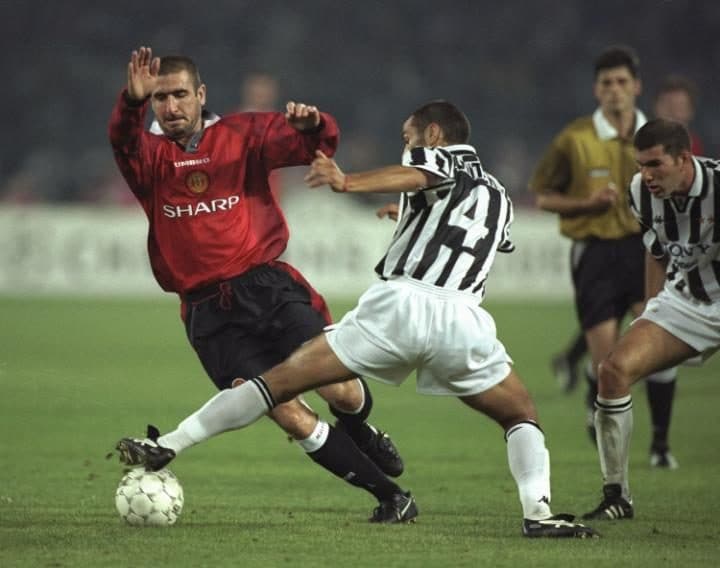 Eric Cantona is tackled by Juventus' Paolo Montero in Turin in 1996 - the striker's performance became the reason for the author's first big argument with his manager. CREDIT: GETTY IMAGES.
Eric Cantona is tackled by Juventus' Paolo Montero in Turin in 1996 - the striker's performance became the reason for the author's first big argument with his manager. CREDIT: GETTY IMAGES.
It should be said that in the absence of any options my attempts to dribble out of midfield that night were at the less successful end of the scale. My argument with Sir Alex ended with me throwing a drink which hit a kit skip and landed at the feet of my boss. I knew exactly what was going to happen. “McClair,” Sir Alex said immediately, “you’re coming on”. Then he looked at me. “And you’re coming off.”
My first attempt to be a dressing room know-it-all had failed miserably. I was fined one week’s wages. I never forgot that lesson and it also planted a seed in my mind about Juventus. That was where we had to get to. That was the team we had to beat, and although we lost both group games against them that season, we did eventually match them and then go one better.
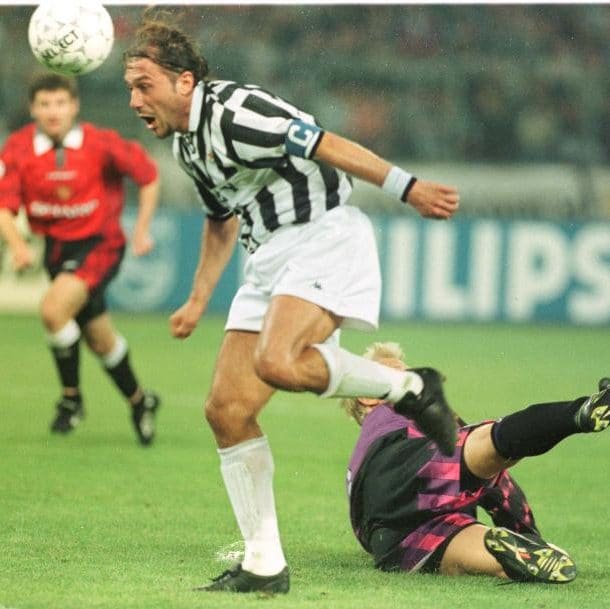 It was apparent in 1996 that 'Conte was a leader and a very accomplished player'. CREDIT: RUSSELL CHEYNE FOR THE TELEGRAPH.
It was apparent in 1996 that 'Conte was a leader and a very accomplished player'. CREDIT: RUSSELL CHEYNE FOR THE TELEGRAPH.
Back then, I could tell that Conte was a leader, and a very accomplished player. He was made captain when Gianluca Vialli left for Chelsea in the summer of 1996. Conte got from box to box and he scored goals. That first night in Turin, he and Deschamps took the ball off me more times than I care to remember. When finally we played Juventus in the 1999 Champions League semi-finals, the pair of us scored our teams’ goals in the 1-1 first leg draw at Old Trafford.
I see something of that great Juventus side in his current Chelsea team. First of all, that Juventus team was built on an excellent defence, and that very aggressive pairing of Paolo Montero and Ciro Ferrara who are different players to the three whom Conte has at Chelsea but equally effective. All of those Juventus players knew their place in Lippi’s 4-3-3 system inside out which is why they made it work better than any other side.
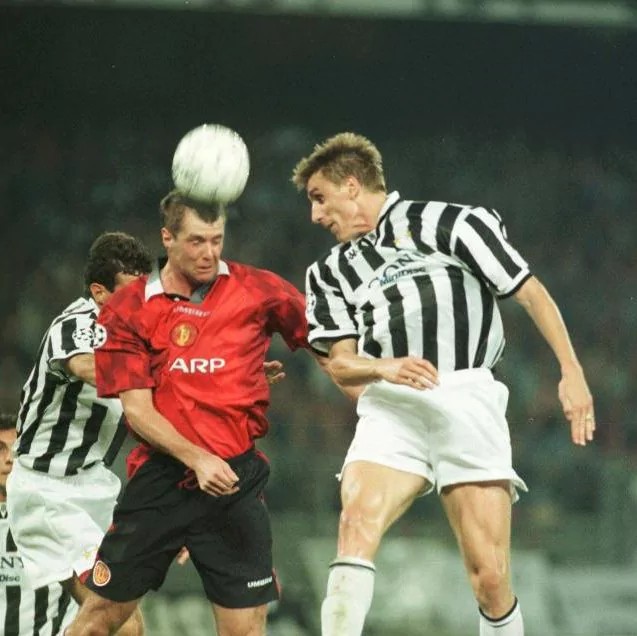 Gary Pallister was kept on his toes all night by Alen Boksic. CREDIT: RUSSELL CHEYNE FOR THE TELEGRAPH.
Gary Pallister was kept on his toes all night by Alen Boksic. CREDIT: RUSSELL CHEYNE FOR THE TELEGRAPH.
When Conte was announced as Chelsea’s next manager in April, I asked Matteo Darmian how he thought his national team manager would adapt to the Premier League. Matteo was pretty clear. He said that Conte would have no trouble at all with football in England.
Watching Chelsea you can tell that his players have been very well-schooled in that 3-4-3 system. They know where they are supposed to be in all phases of the game. It was the same with the great United sides I played in. Over the years, you could hit a blind pass with confidence because you knew that Ole Gunnar Solskjaer, or Ruud Van Nistelrooy or Patrice Evra would be there. We knew our system well.
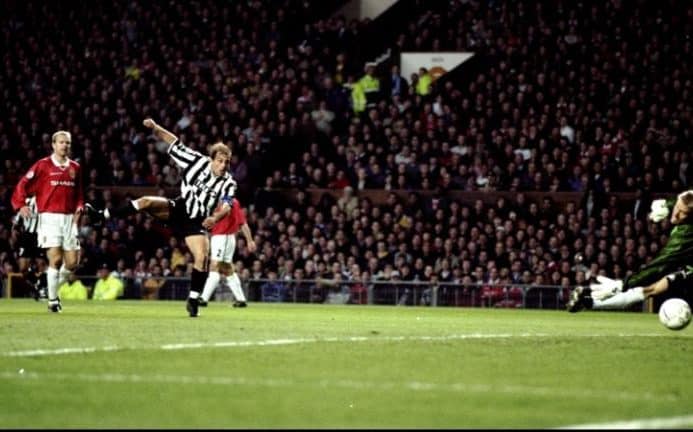 Conte scores Juventus' goal in the 1-1 draw during the Old Trafford first leg of the 1999 Champions League semi-final. CREDIT: SHAUN BOTTERILL/ALLSPORT/GETTY IMAGES.
Conte scores Juventus' goal in the 1-1 draw during the Old Trafford first leg of the 1999 Champions League semi-final. CREDIT: SHAUN BOTTERILL/ALLSPORT/GETTY IMAGES.
When opposing managers go up against Conte’s Chelsea there has been a temptation for some of them to change their system to match up his 3-4-3, and by and large it is possible to do that defensively. Where teams struggle to make it work is offensively because the wing-back position is very specialised and Victor Moses and Marcos Alonso are often the furthest advanced of all the Chelsea players.
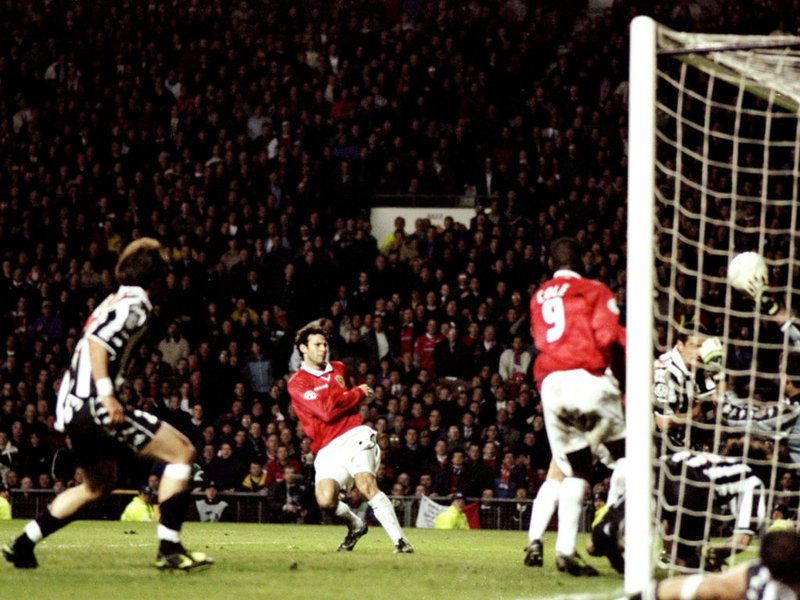 Giggs slams home the late equaliser that sent Manchester United to Turin all-square where they pulled off one of their most famous victories. CREDIT: SHAUN BOTTERILL/ALLSPORT/GETTY IMAGES.
Giggs slams home the late equaliser that sent Manchester United to Turin all-square where they pulled off one of their most famous victories. CREDIT: SHAUN BOTTERILL/ALLSPORT/GETTY IMAGES.
For either a winger or a full-back that can feel a bit unnatural – but it is what makes the formation work so well. It means that the team always have width. In addition they have Diego Costa running the channels, although he will be suspended on Boxing Day against Bournemouth. As well as that they have the likes of Eden Hazard, Pedro or Willian in the pockets of space behind the striker. Nemanja Matic and N’Golo Kante – also suspended for Boxing Day – protect the defence.
 Cesar Azpilicueta Gary Cahill, two of Chelsea's tight back three under Conte, celebrate victory over Manchester City. CREDIT: PAUL ELLIS/AFP.
Cesar Azpilicueta Gary Cahill, two of Chelsea's tight back three under Conte, celebrate victory over Manchester City. CREDIT: PAUL ELLIS/AFP.
Like all good teams, Chelsea made the pitch feel very small when they do not have the ball and then, in an instant, when they do have it they can make the pitch feel very big. When you think that there have only been a couple of major formation changes in the history of the Premier League – from variations on 4-4-2 to the 4-2-3-1 that you see now – then what Conte has done is bold.
When the managerial superstars were assembled at the start of the Premier League season, it was possible that Conte was underestimated by a British audience. He had never managed outside of Italy and there were others who were better known in our game. But Conte, as a player, was part of one of the finest teams I have ever faced, and as a coach he has taken all that experience to build a Chelsea side that is very difficult to beat.
Conte has shown he knows how to handle big players - as Louis van Gaal did at Manchester United
As well as making big tactical changes, Antonio Conte has also shown that he is a very good man-manager. He has made the decision to leave out John Terry, currently injured, a fixture in the Chelsea team, on and off, for the past 16 years.
Knowing how to do that is a real skill for any manager. Louis Van Gaal was an excellent manager of players’ expectations, as I saw first-hand over the previous two seasons. There is no great secret to it. You have to be honest and respectful to players and most of the time they will respond in kind.
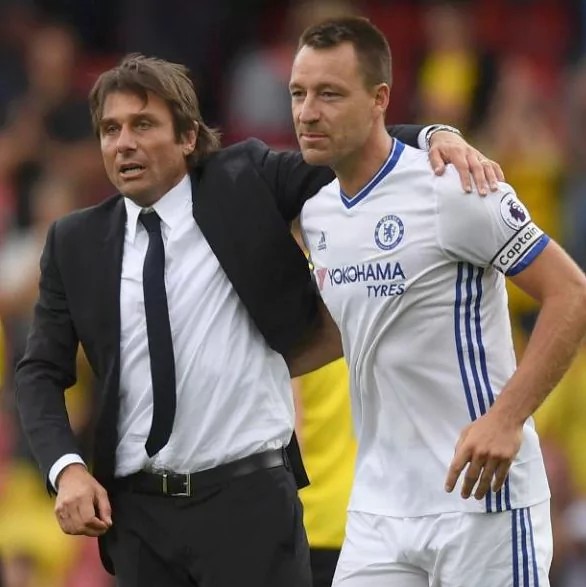 Even though he isn't playing at the moment, the relationship between Conte and the club captain Terry is vital. CREDIT: MARK PAIN/REX/SHUTTERSTOCK.
Even though he isn't playing at the moment, the relationship between Conte and the club captain Terry is vital. CREDIT: MARK PAIN/REX/SHUTTERSTOCK.
They may not always like what is being said to them but if a manager is up front about his opinions then the relationship can survive.
Louis would say to a player he was prepared to sell that, although they were free to find a new club, they would be welcomed back to the first team as a valued member of the squad if that did not happen by the time the transfer window closed.
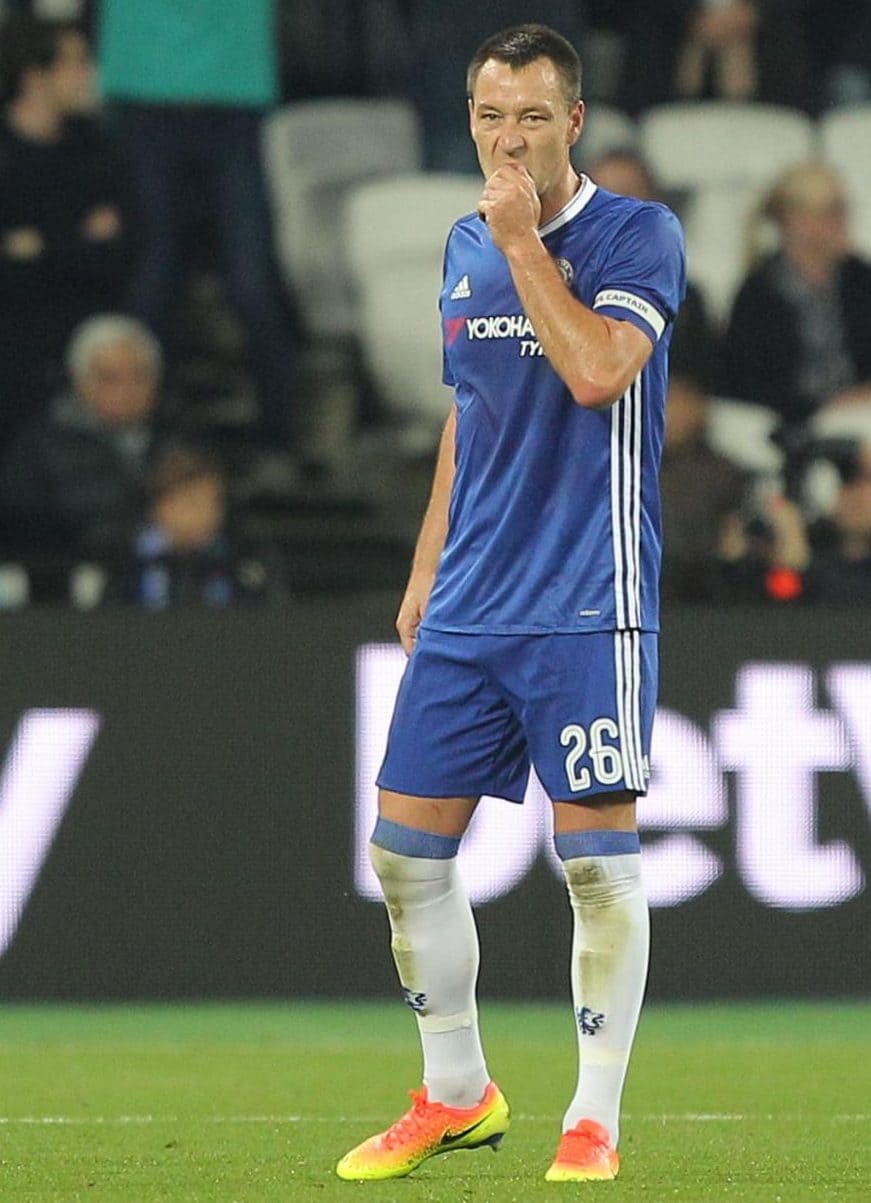 John Terry will bide his time, knowing an opportunity will come. CREDIT: ZEMANEK/BPI/REX/SHUTTERSTOCK.
John Terry will bide his time, knowing an opportunity will come. CREDIT: ZEMANEK/BPI/REX/SHUTTERSTOCK.
Conte has had to leave out Terry but he will know that there could be a time when he needs to call on his club captain again. It helps that Chelsea are winning games because by extension that means that the manager’s authority grows.
I don’t know Terry but he strikes me as a player who always wants his club and his team-mates to do well. He would much rather he was playing – I was no different – but he has enough experience to know that his chance will come sooner or later.
Communication between a manager and his club captain is vital. Even if the captain is not playing he is still the point of contact between the coaching staff and the dressing room and that relationship goes a long way to setting the tone for the way that the rest of the squad feels.
At the moment Conte is managing without Terry and the 3-4-3 formation has kept nine clean sheets in the run of 11 straight wins. He needs to know that Terry is there when he has to call on him.
More from Ryan Giggs:
- This is a glorious chance for Manchester United to make European history again
- What happened will never leave us, but Manchester's compassion and spirit will unite and strengthen
- I had to prepare psychologically for life after Manchester United
- Where the Arsenal vs Man City FA Cup semi-final will be won and lost
- Where the Chelsea vs Spurs FA Cup semi-final will be won and lost
- Ryan Giggs's Premier League team of the season so far: Who makes the cut?
- Manchester United must turn fixture pile-up to their advantage - just like Ferguson did
- Money is making teenage players richer - not better
- Ross Barkley is no longer a kid - his excellence needs to become the norm
- Now Pep Guardiola knows how big his job really is at Manchester City
- Why referees must show the human touch
- Archery, the right suit and teamwork: how to win a cup final
- Arsenal can still thrive – even if Arsene Wenger departs
- I wish Manchester United had signed N'Golo Kante
- The secret to closing out a Premier League title race
- Danny Rose has all the qualities of my old Man Utd mate Patrice Evra
- Why Manchester City's struggles are no surprise
- Zlatan Ibrahimovic has the same aura as Eric Cantona - and is just as lethal
- The night Antonio Conte provoked me into confronting Sir Alex Ferguson - it didn't end well
- Why old-school defending is a dying art
- Mauricio Pochettino has given Spurs a steel they used to lack
- Marcus Rashford can be Manchester United's next No. 9
- The day Pep Guardiola almost forced me to quit football
- Why Man Utd vs Arsenal was my ultimate grudge match
- How going long can beat Jurgen Klopp's gegenpress
- Why I fear this could be Liverpool's year in the Premier League title race
- I have discovered that even Arsenal players can be great company!
- Sir Alex Ferguson left a huge void at Manchester United but decline was not inevitable


